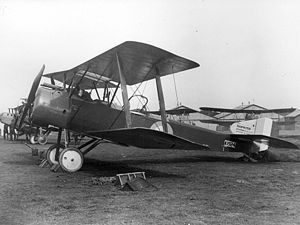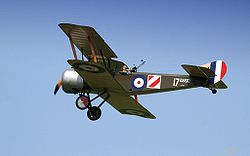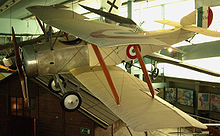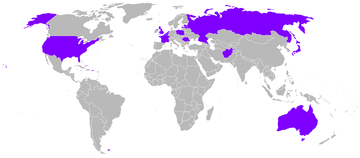Sopwith 1A Strutter Video - November 1917
|
|
Sopwith 1A Strutter
Sopwith 1A Strutter

Role: Biplane general purpose aircraft
Manufacturer: Sopwith Aviation Company
First flight: December 1915
Introduction: April 1916
Primary users: Royal Naval Air Service
Royal Flying Corps
Aéronautique Militaire
Number built: 4,500 France
1,439 Great Britain
The Sopwith 1½ Strutter was a British one or two-seat biplane multi-role aircraft of the First World War. It is significant as the first British-designed two seater tractor fighter, and the first British aircraft to enter service with a synchronised machine gun. It also saw widespread but rather undistinguished service with the French Aéronautique Militaire.
Design and development
In December 1914, the Sopwith Aviation Company designed a small, two seat biplane powered by an 80 hp (60 kW) Gnome rotary engine, which became known as the "Sigrist Bus" after Fred Sigrist, Sopwith's Works Manager. The Sigrist Bus first flew on 5 June 1915, and although it set a new British altitude record on the day of its first flight, only one was built, serving as a company runabout.
The Sigrist Bus formed the basis for a new, larger fighter aircraft, the Sopwith LCT (Land Clerget Tractor), designed by Herbert Smith, powered by a 110 hp (82 kW) Clerget engine. Like the Sigrist Bus, each of the upper wings (there was no true centre section) were connected to the fuselage by a pair of short (half) struts and a pair of longer struts, forming a "W" when viewed from the front, this giving rise to the aircraft's popular nickname of the 1½ Strutter. The first prototype was ready in mid December 1915, undergoing official testing in January 1916.
The 1½ Strutter was of conventional, wire braced, wood and fabric construction. The pilot and gunner sat in widely separated tandem cockpits, with the pilot sitting in front, giving the gunner a good field of fire for his Lewis gun. The aircraft had a variable incidence tailplane that could be adjusted by the pilot in flight, and airbrakes under the lower wings to reduce landing distance.
The Vickers-Challenger interrupter gear was put into production for the Royal Flying Corps in December 1915 and in a few weeks a similar order for the Scarff-Dibovski gear was placed for the RNAS. Early production 1½ Strutters were fitted with one or the other of these gears for the pilot's fixed .303-in Vickers machine gun; due to a shortage of the new gears some early aircraft were built with only the observer's gun. Later aircraft standardised on the improved Ross gear, although the Sopwith-Kauper gear was also fitted. None of these early mechanical synchronisation gears were very reliable and it was not uncommon for propellers to be damaged, or even entirely shot away.
The Scarff ring mounting was also new and production was at first slower than that of the aircraft requiring them. Various makeshift Lewis mountings as well as the older Nieuport ring mounting, were fitted to some early 1½ Strutters as an interim measure. The two-seaters could carry four 25 lb (11 kg) bombs underwing, which could be replaced by two 65 lb (30 kg) bombs for anti-submarine patrols.
From the beginning a dedicated light bomber version was planned, with the observer's cockpit eliminated to allow for more fuel and bombs to be carried in the manner of the Martinsyde Elephant and the B.E.12.

Picture - A replica Sopwith 1½ Strutter flying at a 2006 air show
Operational history
The prototype two-seater flew in December 1915 and production deliveries started to reach the RNAS in February 1916. By the end of April, No. 5 Wing RNAS had a complete flight equipped with the new aircraft. The Sopwiths were used both for escorting the Wing's Caudron G.4 and Breguet bombers and for carrying out bombing raids themselves. The War Office had ordered the type for the RFC in March but because Sopwith's entire production capacity was pre-contracted to the navy, the RFC orders had to be placed with Ruston Proctor and Vickers and production from these manufacturers did not get into its stride until August. Since the Somme offensive was planned for the end of June and with the RFC having a shortage of up-to-date aircraft to support the planned offensive, it was agreed that a number of Sopwiths would be transferred from one service to the other, allowing No. 70 Squadron to reach the front by early July 1916, with Sopwith-built Strutters originally intended for the Navy.
At first No. 70 did very well with their new mounts. The period of German ascendency known as the Fokker scourge was long over and the 1½ Strutter's long range, coupled with its excellent armament for the period, enabled effective offensive patrolling deep into German held territory. Unfortunately, by the time No. 45 Squadron reached the front in October the new Albatros fighters were appearing in the Jagdstaffeln. By January 1917, when No 43 Squadron arrived in France, the type was outclassed as a fighter. While the fitting of a more powerful 130 hp Le Clerget 9B improved performance slightly, this came too late to reverse the situation. It was still a useful long-range reconnaissance aircraft when it could be provided with adequate fighter escort.
Like most early Sopwith types, the 1½ Strutter was very lightly built and its structure did not stand up very well to arduous war service. It was also far too stable to make a good dogfighter. The last front line 1½ Strutters in the RFC were replaced by Camels in late October 1917.
This was by no means the end of the story as far the Sopwith two seater's service was concerned. The type's long range and stability were good qualities for a home defence fighter and it served with three home defence squadrons, No. 37, No. 44 and No. 78 Squadrons. Most of the 1½ Strutters supplied to home defence units had been built as two seaters but many were converted "in the field" to single seaters in order to improve performance. Some of these single seaters were similar to the bomber variant but others were of different type, known (like similarly adapted Sopwith Camels) as the Sopwith Comic. The cockpit was moved back behind the wings and one or two Lewis guns, either mounted on Foster mountings or fixed to fire upwards, outside the arc of the propeller replaced the synchronised Vickers.
The RNAS used most of their 1½ Strutters as bombers (in the Aegean and Macedonia as well as in France) and as shipboard aircraft. In this service it was known as the Ship's Strutter and flew from aircraft carriers and other warships of the Royal Navy.
The RNAS and the RFC (and after April 1918 the RAF) used the type as a trainer after its operational days were over. Like the Pup, it proved a popular personal aircraft for senior officers.
The largest user of the Sopwith was the French Aéronautique Militaire. By October 1916 it was obvious that the pusher Farman and Breguet bombers of the time had become obsolete and pending the appearance of French tractor aircraft the Sopwith was ordered in very large numbers from French manufacturers - in three versions, the SOP. 1A2 (two seater reconnaissance), SOP. 1B2 (two seater bomber) and SOP. 1B1 (single seater bomber). For want of a better alternative the French Sopwiths had to soldier on long after they had become obsolete and were not fully replaced by later types until early 1918. Three Belgian and three American squadrons also flew French-built Sopwiths and some seem to have been supplied to Russia. Surplus French Sopwiths were used by several countries post-war.
Over 100 1½ Strutters were also built in Russia by Duks and Lebedev, supplemented by large numbers delivered directly from Britain and France. The 1½ Strutter remained in large scale use by both the Soviet forces and White Russians during the Russian civil war and Polish-Soviet war. Three were captured during this war and used by the Poles in 1919-1920. Other captured ones were used by Baltic states.
Around 1,500 1½ Strutters were built for the Royal Flying Corps and the Royal Naval Air Service and between 4,200 and 4,500 were built in France.
Variants
Sopwith Type 9400
Official Admiralty designation for two seater version.
Sopwith Type 9700
Admiralty designation for single seater bomber.
Sopwith Two-seater
Oficial RFC designation.
Sopwith 1½ Strutter
Universally used but "non-official" name for two-seat fighter-scout, bomber and reconnaissance versions.
Sopwith Comic
Single seat home defence fighter
Ship Strutter
Shipboard version
SOP. 1
French built version.
LeO 1
Lioré et Olivier licence-built version.
So-shiki Model 1
Japanese licence-built bomber version.
So-Shiki Model 2
Japanese licence-built LeO 1 reconnaissance version.
Survivors

Picture - Sopwith No. 556 on display in the Musee de l'Air et de l'Espace at Paris le Bourget
Original Sopwith 1½ Strutter aircraft are preserved at the following locations. Replica aircraft are not listed.
Belgium
S85, Koninklijk Legermuseum/Musee Royal de l'Armee, Brussels.
France
No. 556, Sop.1A.2 at Musée de l'Air et de l'Espace, Paris Le Bourget airport.
France
No. 2897, Sop.1B.2 at the Association Memorial Flight, La Ferté-Alais near Paris (under restoration 2009).
USA
The Fantasy of Flight museum at Polk City, Florida contains an unrestored 1½ Strutter obtained from Argentina.
Operators
Military

Picture - 1½ Strutter operators.
Afghanistan
Afghanistan Air Force acquired a few aircraft from 1921 and retired in 1925.
Australia
Australian Flying Corps
No. 2 Squadron AFC operated one aircraft for training only.
No. 4 Squadron AFC used Strutters for training.
No. 6 (Training) Squadron AFC in the United Kingdom
Belgium
Aviation Militaire Belge.
2x¨me Escadrille
3x¨me Escadrille
4x¨me Escadrille
6x¨me Escadrille
Brazil
Escola de Aviax§ia Militar used three aircraft for liasison and army co-operation duties.
Estonia
Estonian Air Force operated a single ex-Soviet aircraft.
France
Aéronautique Militaire A total of 72 Escadrilles equipped either wholly or partly.
Greece
Six aircraft used in the Asia Minor Campaign against Turkey, 1918-21.
Japan
Imperial Japanese Army Air Service
Latvia
Latvian Air Force operated at 4 ex-Soviet aircraft.
Lithuania
Lithuanian Air Force operated a single ex-Soviet aircraft that landed behind Lithuanian lines during the Lithuanian-Soviet War. Two others may also have been operated.
Mexico
Arma de Aviacix³n Militar operated one example (TNCA registration 1-S-68) from c1920 - 1924.
Netherlands
Luchtvaart Afdeling used five 1½ Strutters that forced landed in neutral Holland and were interned and subsequently purchased.
Poland
Polish Air Force operated 3 aircraft captured from the Soviets in 1919-1920.
Romania
Royal Romanian Air Force
Russia
Imperial Russian Air Force and White Russian forces
Soviet Union
Soviet Air Force
Ukraine
A single aircraft acquired from Russia in 1918.
United Kingdom
Royal Flying Corps
No. 37 Squadron RFC
No. 39 Squadron RFC
No. 43 Squadron RFC
No. 44 Squadron RFC
No. 45 Squadron RFC
No. 46 Squadron RFC
No. 70 Squadron RFC
No. 78 Squadron RFC
No. 143 Squadron RFC
Royal Naval Air Service
United States
Aviation Section, U.S. Signal Corps purchased 384 two-seat observation aircraft and 130 single seat bombers from France in 1917-18. While mainly used for training, they were used operationally by the 90th Aero Squadron as an interim measure, due to a shortage of later types.
United States Navy
Civil
Argentina
Two aircraft registered in 1928. R-105 (later LV-BAA) and R-106 (later LV-CAA). One of these two preserved in Florida.
France
55 aircraft on French civil register in 1922.
Japan
At least seven aircraft registered.
Sweden
Possibly one aircraft from Switzerland in 1926.
Switzerland
Two aircraft, CH-53 registered 9 April 1921, cancelled 9 October 1923. CH-67 registered 5 December 1923, cancelled December 1926 as sold to Sweden.
United Kingdom
One civil registered aircraft, G-EAVB.
Specifications (1½ Strutter - two seater, 130 hp Clerget)
Data from British Aeroplanes 1914-18
General characteristics
Crew: two, pilot and observer
Length: 25 ft 3 in (7.70 m)
Wingspan: 33 ft 6 in (10.21 m)
Height: 10 ft 3 in (3.12 m)
Wing area: 346 ft² (32.16 m²)
Empty weight: 1,305 lb (593 kg)
Loaded weight: 2,149 lb (975 kg)
Max takeoff weight: 2,150 lb (977 kg)
Powerplant: 1x— Clerget 9B rotary engine, 130 hp (97 kW)
Performance
Maximum speed: 100 mph (87 knots, 161 km/h) at 6,500 ft (1,980 m)
Endurance: 3¾ hours
Service ceiling: 15,500 ft (4,730 m)
Climb to 6,500 ft (1,980 m): 9 min 10 s
Armament
Guns:
1 x— .303 in (7.7 mm) forward-firing Vickers machine gun with Ross interrupter gear
1 x— .303 in (7.7 mm) Lewis gun in observer's cockpit
Bombs: Up to 130 lb (60 kg) bombs
Related development
Sopwith Pup
Comparable aircraft
Bristol F.2 Fighter
Bibliography
Bruce, J.M. "The Sopwith 1½ Strutter: Historic Military Aircraft No. 14 Part I." Flight, 28 September 1956, pp. 542-546.
Bruce, J.M. "The Sopwith 1½ Strutter: Historic Military Aircraft No. 14 Part II." Flight, 5 October 1956, pp. 586-591.
Bruce J.M. British Aeroplanes 1914-18. London:Putnam, 1957.
Bruce, J.M. The Aeroplanes of the Royal Flying Corps (Military Wing). London: Putnam, 1982. ISBN 0 370 30084 x.
Gerdessen, F. "Estonian Air Power 1918 - 1945". Air Enthusiast No 18, April - July 1982, pp. 61-76. ISSN 0143-5450.
Jarrett, Philip. "Database:The Sopwith 1½ Strutter". Aeroplane, December 2009, Vol 37 No 12, Issue No 440. London:IPC. ISSN 0143-7240. pp.55-70.
Kopański, Tomasz Jan. Samoloty brytyjskie w lotnictwie polskim 1918-1930 (British aircraft in the Polish air force 1918-1930)(in Polish). Warsaw: Bellona, 2001. ISBN 83-11-09315-6.
Lake, Jon. The Great Book of Bombers: The World's Most Important Bombers from World War I to the Present Day. St. Paul, MN: MBI Publishing Company, 2002. ISBN 0-7603-1347-4.
Swanborough, F.G. and Peter Bowers. United States Military Aircraft since 1909. London: Putnam, 1963.
Swanborough Gordon and Peter Bowers. United States Navy Aircraft since 1911. London: Putnam, Second edition 1976. ISBN 0-370-10054-9.
Taylor, John W.R. "Sopwith 1½ Strutter". Combat Aircraft of the World from 1909 to the Present. New York: G.P. Putnam's Sons, 1969. ISBN 0-425-03633-2.
Thetford, Owen. British Naval Aircraft since 1912. London: Putnam, Fourth edition 1978. ISBN 0-370-30021-1.
Visatkas, C. "The Annals of Lithuanian Aviation". Air Enthusiast, Number Twenty-nine, November 1985-February 1986, pp. 61-66. Bromley, UK:Fine Scroll. ISSN 0143-5450.
Sopwith 1A Strutter Pictures and Sopwith 1A Strutter for Sale.
Living Warbirds: The best warbirds DVD series.
Source: WikiPedia